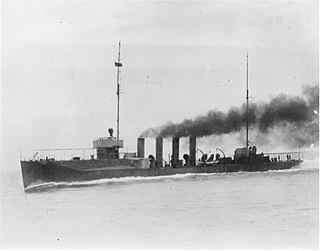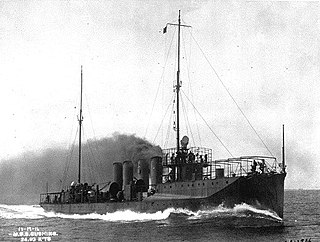
USS Reuben James (DD-245) was a four-funnel Clemson-class destroyer that was constructed after World War I. She was the first United States Navy ship to be named after Boatswain's Mate Reuben James, who had distinguished himself fighting in the First Barbary War, and was the first US ship to be sunk by hostile action in the European Theater of World War II.

USS Jacob Jones was a Tucker-class destroyer built for the United States Navy prior to the American entry into World War I. The ship was the first U.S. Navy vessel named in honor of Jacob Jones.

The first USS Patterson (DD-36) was a modified Paulding-class destroyer in the United States Navy during World War I and later in the United States Coast Guard, designated as CG-16. She was named for Daniel Patterson.

The first USS Fanning (DD-37) was a modified Paulding-class destroyer in the United States Navy during World War I and later in the United States Coast Guard, designated as CG-11. Her namesake was Nathaniel Fanning.

The O'Brien class of destroyers was a class of six ships designed by and built for the United States Navy shortly before the United States entered World War I. The O'Brien class was the third of five classes of destroyers that were known as the "thousand tonners", because they were the first U.S. destroyers over 1,000 long tons (1,016 t) displacement.

USS O'Brien was the lead ship of O'Brien-class destroyers built for the United States Navy prior to the American entry into World War I. The ship was the second US Navy vessel named in honor of Jeremiah O'Brien and his five brothers Gideon, John, William, Dennis, and Joseph who, together on the sloop Unity, captured a British warship during the American Revolutionary War.

USS Nicholson was an O'Brien-class destroyer built for the United States Navy before the American entry into World War I. The ship was the second U.S. Navy vessel named in honor of five members of the Nicholson family who rendered distinguished service in the American Revolutionary War, the War of 1812, and the American Civil War: brothers James, Samuel, and John Nicholson; William Nicholson, son of John; and James W. Nicholson, grandson of Samuel.

USS Winslow was an O'Brien-class destroyer built for the United States Navy prior to the American entry into World War I. The ship was the second US Navy vessel named in honor of John Ancrum Winslow, a US Navy officer notable for sinking the Confederate commerce raider CSS Alabama during the American Civil War.

USS McDougal was an O'Brien-class destroyer built for the United States Navy prior to the American entry into World War I. The ship was the second U.S. Navy vessel named in honor of David Stockton McDougal, a U.S. Navy officer notable for his leadership during an 1863 battle off Japan while in command of Wyoming.

USS Cushing was an O'Brien-class destroyer built for the United States Navy prior to the American entry into World War I. The ship was the second U.S. Navy vessel named in honor of William B. Cushing, a U.S. Navy officer best known for sinking the Confederate ironclad warship CSS Albemarle during the American Civil War.

USS Ericsson was an O'Brien-class destroyer built for the United States Navy prior to the American entry into World War I. The ship was the second U.S. Navy vessel named in honor of John Ericsson, the Swedish-born builder of the ironclad warship USS Monitor during the American Civil War.

German submarine U-550 was a Type IXC/40 German Navy U-boat built during World War II. She was laid down on 2 October 1942 by Deutsche Werft in Hamburg as yard number 371, launched on 12 May 1943 and commissioned on 28 July under the command of Kapitänleutnant Klaus Hänert.

USS Otter (DE-210), a Buckley-class destroyer escort of the United States Navy, in service from 1944 to 1947. She was finally sunk as a target in 1970.

USS Hayter (DE-212/APD-80) was a Buckley-class destroyer escort in service with the United States Navy from 1943 to 1946. In 1967, she was transferred to South Korea where she served as ROKS Jonnam until 1986.

HMS Aylmer was a Captain-class frigate of the Royal Navy that served during World War II. The ship was named after Matthew Aylmer, commander of HMS Royal Katherine at the Battle of Barfleur in 1692 during the War of the Grand Alliance.

USS Gustafson (DE-182) was a Cannon-class destroyer escort in service with the United States Navy from 1943 to 1946. In 1950, she was transferred to the Royal Netherlands Navy where she served as Hr.Ms. Van Ewijck (F808) until 1967. She was scrapped in 1968.

The Atlantic U-boat campaign of World War I was the prolonged naval conflict between German submarines and the Allied navies in Atlantic waters—the seas around the British Isles, the North Sea and the coast of France.

Operation Teardrop was a United States Navy operation during World War II, conducted between April and May 1945, to sink German U-boats approaching the Eastern Seaboard that were believed to be armed with V-1 flying bombs. Germany had threatened to attack New York with V-1 flying bombs and rocket U-boats. After the war, it was determined the submarines had not been carrying either.

The Battle of Point Judith is the popular name for a naval engagement fought between the United States and Nazi Germany during World War II on May 5 and 6, 1945 - with Germany on the verge of total defeat and surrender, and Hitler having already died by suicide. American surface combatants and two blimps sank a German U-boat off Point Judith, Rhode Island in one of the last actions of the Battle of the Atlantic. The SS Black Point a 368-foot, 7,500-ton coal ship was sunk at the start of the Battle.

United States Navy operations during World War I began on April 6, 1917, after the formal declaration of war on the German Empire. The United States Navy focused on countering enemy U-boats in the Atlantic Ocean and the Mediterranean Sea while convoying men and supplies to France and Italy. Because of United States's late entry into the war, her capital ships never engaged the German fleet and few decisive submarine actions occurred.




















